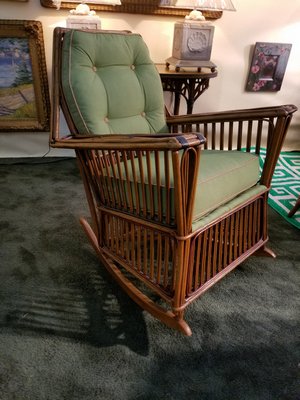
Last month I attended the East Hampton Historical Society’s Antiques Show at Mulford Farm. It was a beautiful night for a soirée and I was sure that all my collector’s juices would be churning as I roamed about looking for a good “summer” theme to write about.
Well after breezing by all the jewelry cases, the bric-a-brac and the questionable, I finally came upon a few dealers who had what I consider good goods. That is, the dealer and the furniture both have good, solid provenance. They know what they’re collecting and are proud of their collections of furniture, antique objects and accessories. It was at one such dealer’s booth that I met the charming and knowledgeable James T. Butterworth, owner of Antique American Wicker, who offered me a mini-lesson in the history and fine art of wicker furniture making in the United States. What a perfect combination: a dealer who knows his stuff and a product that is quintessential summer furniture. I couldn’t help but think of the comforting creaks of my grandmother’s porch wicker chairs on many summer nights while enjoying a slight ocean breeze and an iced tea.
Of course, today sitting on a porch or veranda while the world goes by is out of the question since the time will inevitably be interrupted by text messages, phone calls or someone wanting to know where you are and what you’re doing—not for any particular reason, either. Most household wicker today has been relegated to bathroom wastebaskets and clothes hampers. It wasn’t always this way. In fact, wicker has a long—really long—and noble history. The Sumerians had it, so did the Greeks and Egyptians as well as the Romans. The first piece of wicker furniture landed in America on the Mayflower in 1620—it was a wicker baby cradle! Some contend, and I tend to agree, that wicker found its fullest and best expression in America. Completely versatile, every time there was a major change of status of the middle-class, wicker changed with it. It can be seen as a reflection of taste and fashion in American over the period of roughly 1850 to 1950.
So what is wicker and why do we have so many names for it? Wicker is a technique for producing woven items from any of the cane-like materials; it is a generic name for any plant-based material, i.e., rattan, willow, reed and bamboo. In short, wicker is the weaving technique and rattan is the material. Its main benefit is that it’s light but sturdy, making it ideal for things that need to be moved like porch and patio furniture. By the 19th century, wicker was very popular in Europe, being used indoors and outdoors because it was inexpensive, resisted harsh weather and was easily adaptable in terms of style. The Victorians believed it to be more sanitary than upholstered furniture.
It took a plucky and inventive American, Cyrus Wakefield of Massachusetts, in the mid-1800s to start making wicker furniture in the United States. He noticed that in ports there was a lot of used rattan on the docks due to the fact that it was used as ballast on ships. He started using it to make furniture and it was an immediate success so he began importing it himself for the rapidly expanding business. His company later merged with the Heywood Chair Manufacturing Company that had invented a mechanical system for weaving wicker seats. Together they became the Heywood-Wakefield Company of Gardner, Massachusetts, later re-named Wakefield in thanks to Mr. Wakefield for providing so many jobs to the town.
In the late 19th century popular forms of wicker were produced with intricate curlicues, twists and ornament. There were wicker side tables, wicker reception chairs and wicker settees—some having motifs li
Old wicker furniture is not easy to find and prices for fine wicker keep rising, particularly those that reflect the Arts and Crafts style, like the pieces Mr. Butterworth prefers and shows so well. Victorian era wicker, whether painted or not, hasn’t really increased dramatically in price or value in some time due in part to there being so much of it around. But the styles from the pre- and post-World War I era have risen significantly over the years due to the fact that it wasn’t mass produced to the degree its Rococo predecessors were. In either case, having a set or suite of wicker will bring a higher price than a single item unless that single item has a unique history (i.e. from the Mayflower).
There are also some very fine contemporary sources for wicker. Generally speaking, they’re not technically wicker, they’re resin-coated synthetics but they have a good look and like their antique cousins are easy to care for and will last a long time. Serena & Lily, for instance, has a lovely comfortable collection of wicker-like seating as do Restoration Hardware and others. Will it stand the test of time in the wear of the porch or patio? Time will tell, however, nothing brand new can conjure up memories of sitting on a porch on a summer’s day or night while someone gently rocks back and forth in a slightly squeaky wicker rocker and you and your cousin play cards on the wicker ottoman pausing only to catch fireflies and not caring who wins or loses. My vote is with antique American wicker; I think it has stood the test of time, still looks great, still looks stylish and carries just a bit of nostalgia, which makes it irreplaceable.